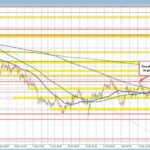CPI: Understanding Its Impact on Inflation and Japan’s Economy
Tháng 4 16, 2025
AUD/USD Set to Break Resistance at 0.6390: Is an Upside Breakout Imminent?
Tháng 4 16, 2025Wall Street Thrives Amidst Market Volatility: Analyzing Recent Trading Activities
Recent fluctuations on Wall Street have presented both opportunities and challenges for trading desks across major financial institutions. As the U.S. navigates the complexities of President Donald Trump’s tariff policies, trading desks are witnessing record-breaking revenue surges, yet the uncertainties in the broader economic landscape pose significant concerns.
Record Trading Revenues in Q1 2025
In a striking display of resilience, the largest U.S. banks have reported nearly $37 billion in trading revenue for the first quarter of 2025. This impressive figure marks the strongest performance for these institutions in over a decade. The spike in trading revenues can be attributed directly to heightened market volatility, which has spurred investors to aggressively adjust their portfolios in response to evolving tariff announcements. Such strategic adjustments have proven lucrative for trading operations, suggesting that adept management of market uncertainties can yield significant financial rewards. For more on notable stock movements during this period, you can check out the analysis on Rocket Lab and Lululemon.
The Effects of Trump’s Tariff Policies
The impact of President Trump’s tariff announcements, particularly the one made on April 2, 2025, reverberated throughout the financial landscape. The announcement triggered a notable market reaction, with the S&P 500 plummeting by 10.5% within just two days, while the NASDAQ suffered a 11.4% decline. The toll of these fluctuations was substantial, erasing approximately $6.6 trillion in market value. Such dramatic shifts underline the delicate balance that markets maintain; while some sectors benefit from volatility, others struggle to adapt to rapid changes. The need for investors to closely monitor stock movements, as seen with Rocket Lab and Lululemon, is crucial during these times.
Investment Banking Challenges Amidst Trading Boom
Despite the uptick in trading revenues, the investment banking sector is bearing the brunt of this uncertainty. Notably, Goldman Sachs reported a staggering 22% drop in advisory revenue, accompanied by a 20% decline for Bank of America. The dissonance between robust trading results and the struggles faced by investment banking highlights the complex and often contradictory nature of financial markets. While trading desks capitalize on the heightened activity, the advisory segments are grappling with diminished client confidence and a slowdown in business deals, a direct consequence of the prevailing economic uncertainty.
Broader Economic Implications
As Wall Street revels in the success of trading, the broader economic outlook appears to be clouded with apprehension. There are apprehensions regarding a cooling economy as various sectors exhibit signs of reevaluation. Investors are increasingly cautious, weighing the risks associated with the volatile market conditions stirred by the ongoing tariff battles. The overarching question remains: how long can trading desks thrive in the face of such unpredictable economic dynamics? Insights into strategic moves within China’s economy can also provide context as countries navigate trade tensions; for instance, details on three strategic moves by China could be pivotal in understanding broader market implications.
In conclusion, while trading has been a boon for many financial institutions within the current climate of volatility, concerns over the health of the investment banking sector indicate a potential imbalance that could have lasting effects on the economic landscape. As financial entities continue to navigate these turbulent waters, the interplay between trading success and investment banking challenges will remain a pivotal narrative for analysts and investors alike.

